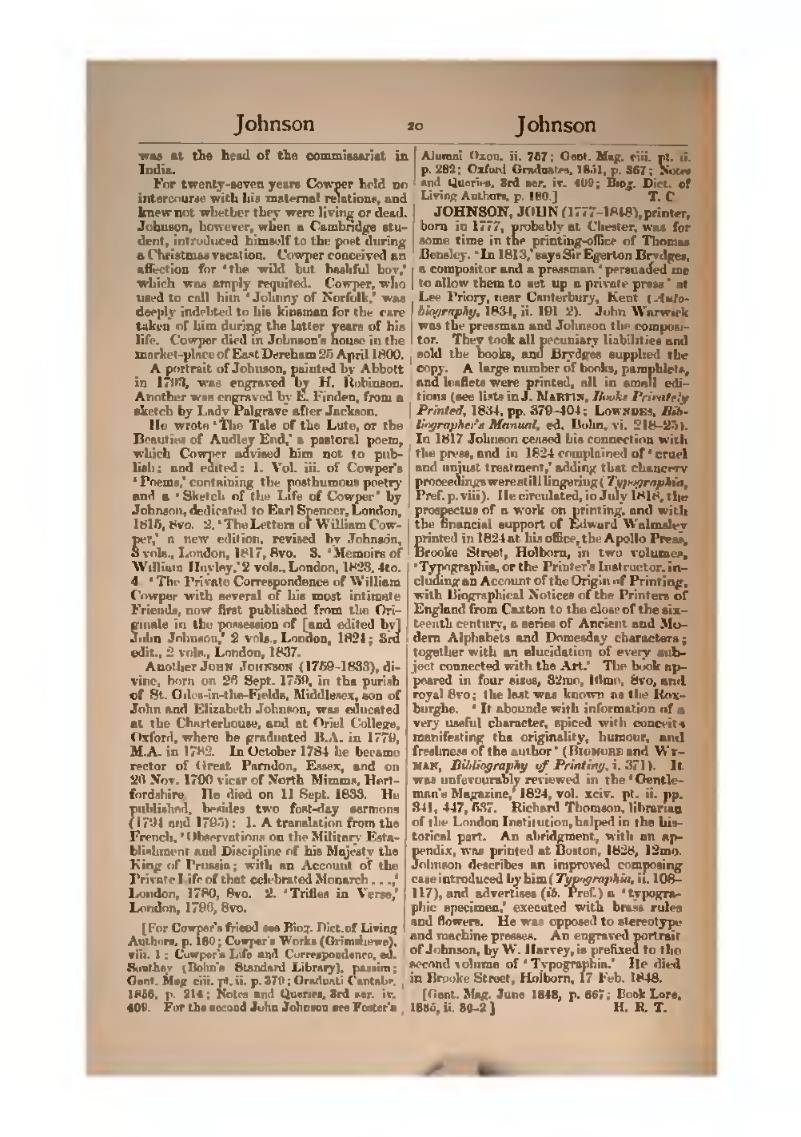was at the head of the commissariat in India.
For twenty-seven years Cowper held no intercourse with his maternal relations, and knew not whether they were living or dead. Johnson, however, when a Cambridge student, introduced himself to the poet during a Christmas vacation. Cowper conceived an affection for ‘the wild but bashful boy,’ which was amply requited. Cowper, who used to call him ‘Johnny of Norfolk,’ was deeply indebted to his kinsman for the care taken of him during the latter years of his life. Cowper died in Johnson's house in the market-place of East Dereham 25 April 1800.
A portrait of Johnson, painted by Abbott in 1793, was engraved by H. Robinson. Another was engraved by E. Finden, from a sketch by Lady Palgrave after Jackson.
He wrote ‘The Tale of the Lute, or the Beauties of Audley End,’ a pastoral poem, which Cowper advised him not to publish; and edited: 1. Vol. iii. of Cowper's ‘Poems,’ containing the posthumous poetry and a ‘Sketch of the Life of Cowper’ by Johnson, dedicated to Earl Spencer, London, 1815, 8vo. 2. ‘The Letters of William Cowper,’ a new edition, revised by Johnson, 3 vols., London, 1817, 8vo. 3. ‘Memoirs of William Hayley,’ 2 vols., London, 1823, 4to. 4. ‘The Private Correspondence of William Cowper with several of his most intimate Friends, now first published from the Originals in the possession of [and edited by] John Johnson,’ 2 vols., London, 1824; 3rd edit., 2 vols., London, 1837.
Another John Johnson (1759–1833), divine, born on 26 Sept. 1759, in the parish of St. Giles-in-the-Fields, Middlesex, son of John and Elizabeth Johnson, was educated at the Charterhouse, and at Oriel College, Oxford, where he graduated B.A. in 1779, M.A. in 1782. In October 1784 he became rector of Great Parndon, Essex, and on 26 Nov. 1790 vicar of North Mimms, Hertfordshire. He died on 11 Sept. 1833. He published, besides two fast-day sermons (1794 and 1795): 1. A translation from the French, ‘Observations on the Military Establishment and Discipline of his Majesty the King of Prussia; with an Account of the Private Life of that celebrated Monarch …,’ London, 1780, 8vo. 2. ‘Trifles in Verse,’ London, 1796, 8vo.
[For Cowper's friend see Biog. Dict. of Living Authors, p. 180; Cowper's Works (Grimshawe), viii. 1; Cowper's Life and Correspondence, ed. Southey (Bohn's Standard Library), passim; Gent. Mag. ciii. pt. ii. p. 379; Graduati Cantabr. 1856, p. 214; Notes and Queries, 3rd ser. iv. 409. For the second John Johnson see Foster's Alumni Oxon. ii. 757; Gent. Mag. ciii. pt. ii. p. 282; Oxford Graduates, 1851, p. 367; Notes and Queries, 3rd ser. iv. 409; Biog. Dict. of Living Authors, p. 180.]
JOHNSON, JOHN (1777–1848), printer, born in 1777, probably at Chester, was for some time in the printing-office of Thomas Bensley. ‘In 1813,’ says Sir Egerton Brydges, a compositor and a pressman ‘persuaded me to allow them to set up a private press’ at Lee Priory, near Canterbury, Kent (Autobiography, 1834, ii. 191–2). John Warwick was the pressman and Johnson the compositor. They took all pecuniary liabilities and sold the books, and Brydges supplied the copy. A large number of books, pamphlets, and leaflets were printed, all in small editions (see lists in J. Martin, Books Privately Printed, 1834, pp. 379–404; Lowndes, Bibliographer's Manual, ed. Bohn, vi. 218–25). In 1817 Johnson ceased his connection with the press, and in 1824 complained of ‘cruel and unjust treatment,’ adding that chancery proceedings were still lingering (Typographia, Pref. p. viii). He circulated, in July 1818, the prospectus of a work on printing, and with the financial support of Edward Walmsley printed in 1824 at his office, the Apollo Press, Brooke Street, Holborn, in two volumes, ‘Typographia, or the Printer's Instructor, including an Account of the Origin of Printing, with Biographical Notices of the Printers of England from Caxton to the close of the sixteenth century, a series of Ancient and Modern Alphabets and Domesday characters; together with an elucidation of every subject connected with the Art.’ The book appeared in four sizes, 32mo, 16mo, 8vo, and royal 8vo; the last was known as the Roxburghe. ‘It abounds with information of a very useful character, spiced with conceits manifesting the originality, humour, and freshness of the author’ (Bigmore and Wyman, Bibliography of Printing, i. 371). It was unfavourably reviewed in the ‘Gentleman's Magazine,’ 1824, vol. xciv. pt. ii. pp. 341, 447, 537. Richard Thomson, librarian of the London Institution, helped in the historical part. An abridgment, with an appendix, was printed at Boston, 1828, 12mo. Johnson describes an improved composing case introduced by him (Typographia, ii. 108–117), and advertises (ib. Pref.) a ‘typographic specimen,’ executed with brass rules and flowers. He was opposed to stereotype and machine presses. An engraved portrait of Johnson, by W. Harvey, is prefixed to the second volume of ‘Typographia.’ He died in Brooke Street, Holborn, 17 Feb. 1848.
[Gent. Mag. June 1848, p. 667; Book Lore, 1885, ii. 30–2.]
